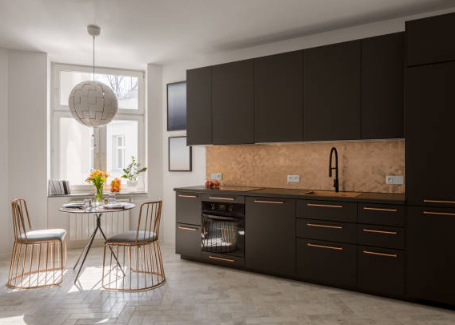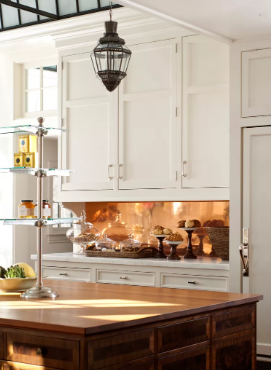
How to Arrange Bedroom Furniture for the Ultimate Sleep Space
July 31, 2024
What Is a Seamless Shower? This Ventilated Bathroom Trend Is More Popular Than Ever
August 5, 2024Copper Backsplashes Are in Vogue: What You Need to Know About Metal Kitchen Décor
When you think of metal kitchen finishes, you probably think of stainless steel. But what about its counterpart, copper? More and more homeowners are gravitating towards this warm metal in their kitchens for a number of reasons.
“Copper can be installed anywhere in the home, but we’re seeing a growing interest in this material specifically for tailgates,” said Mitchell Parker, senior editor at Houzz. “Copper can really take center stage in the kitchen, showing off a warm aesthetic, whether it’s perfectly polished or weathered and worn.”
Copper’s warm, natural appearance makes it a versatile choice for a variety of kitchen styles. It can be dressed up or casual and will suit equally well in both traditional and modern spaces. Get inspired for your own kitchen with our guide to copper backsplashes, including design ideas and care and maintenance tips.

Benefits of Copper Tailgate:
“The copper tailgate is fantastic for those who want the warmth of warm metal but don’t want to pair it with a sleek brass look,” said Victoria Holly, principal and founder of Victoria Holly Interiors. “Copper has a warm and inviting quality that instantly elevates the atmosphere of the kitchen.”
The copper tailgate will also get better over time. Backsplashes made of real copper develop a patina with use and time, and when the metal reacts with oxygen and moisture in the air, it produces a richer color due to oxidation. Oxidation causes the unfinished copper to take on a striking blue-green hue, which helps protect the metal from further corrosion. Ginger Curtis, designer at Urbanology Designs, said: “The patina and worn look created by aging copper over time evokes a sense of history and authenticity, making it a great option for those who appreciate a vintage aesthetic.” ”
In addition to being aesthetically pleasing, a huge benefit of copper backsplashes is their natural antimicrobial properties. “It’s said to be more resistant to bacteria than stainless steel, which makes it a practical choice for the kitchen,” Parker said.
In addition, copper is very durable, which is another benefit to consider when choosing a material to equip a high-traffic room such as a kitchen.

How to Design a Copper Backsplash
Copper is suitable for those who appreciate natural materials and who crave elegance and luxury. And, because there’s no shortage of forms, colors, or finishes – from large, smooth copper plates to hammered copper bricks – there are plenty of options to create a copper backsplash that fits your kitchen.
Traditional Copper Backsplash
With a warm hue and subtle sheen, the copper backsplash is a great choice for a traditional-style kitchen. “For a more traditional kitchen, I’d like to see a textured copper backsplash or pattern,” Curtis said. “This style adds depth and character, complementing the warmth and charm that a traditional kitchen usually brings.”
Jerad Gardemal, designer at JF Gardemal Designs, recommends the use of stamped copper bricks or stamped copper sheets in traditional kitchens. Both options are more practical than a typical tile backsplash, however, he notes, “the beauty and longevity of copper is timeless and chic.” ”
Modern Copper Backsplashes
The warmth of copper makes it perfect for traditional spaces, and it performs just as well in modern kitchens, which often feature cooler metals like stainless steel or chrome.
“Polished or brushed copper surfaces with clean lines can be a great contrast to minimalist cabinets and countertops,” Curtis says. “Modern design elements combined with the warmth of copper create a visually appealing focal point in the kitchen.”
As an added bonus, the reflective properties of the polished copper backsplash gently reflect light around a minimalist kitchen.

How to Clean the Copper Backsplash
The method and frequency of cleaning the copper backsplash depends on the surface treatment and your preference for patina. If your copper backsplash has a very strong varnish and seal, a simple cleaning with mild dish soap and warm water will suffice, as harsh chemicals can peel off the protective coating.
On the other hand, over time, unfinished copper can develop a patina due to oxidation. If you want to control this reaction, limit the frequency of regular cleaning of unfinished copper backsplashes to once every 3 to 6 months. “Warm, soapy water and a soft cloth preserve the integrity of the copper and keep it shiny,” Gardmar said.
However, if you’re looking to remove rust or restore copper to its bright shine, you can create a solution at home to do just that.
- Mix an acid, such as lemon juice or vinegar, with a mild abrasive, such as salt or baking soda, to make a paste.
- Use a soft cloth to gently wipe the paste-coated copper and wipe it in small circular motions.
- Rinse the paste with a damp cloth.
- Wipe the copper backsplash completely dry with a microfiber cloth.

Spend Less Money to Get the Look of a Copper Tailgate
If you want the look of a copper backsplash but want a lower-maintenance or lower-cost option, there are many alternatives available, including glass bricks or a painted faux copper look.
Curtis recommends using copper veneer or copper foil. “These materials have the appearance of copper, while being cheaper and easier to maintain. Copper laminate or metal-effect tiles are another option that can mimic the look of copper without the need for a lot of care.”
Copper-colored stainless steel is another low-maintenance option that has the appearance of copper, has no risk of oxidation, and does not require regular polishing to maintain a patina.



